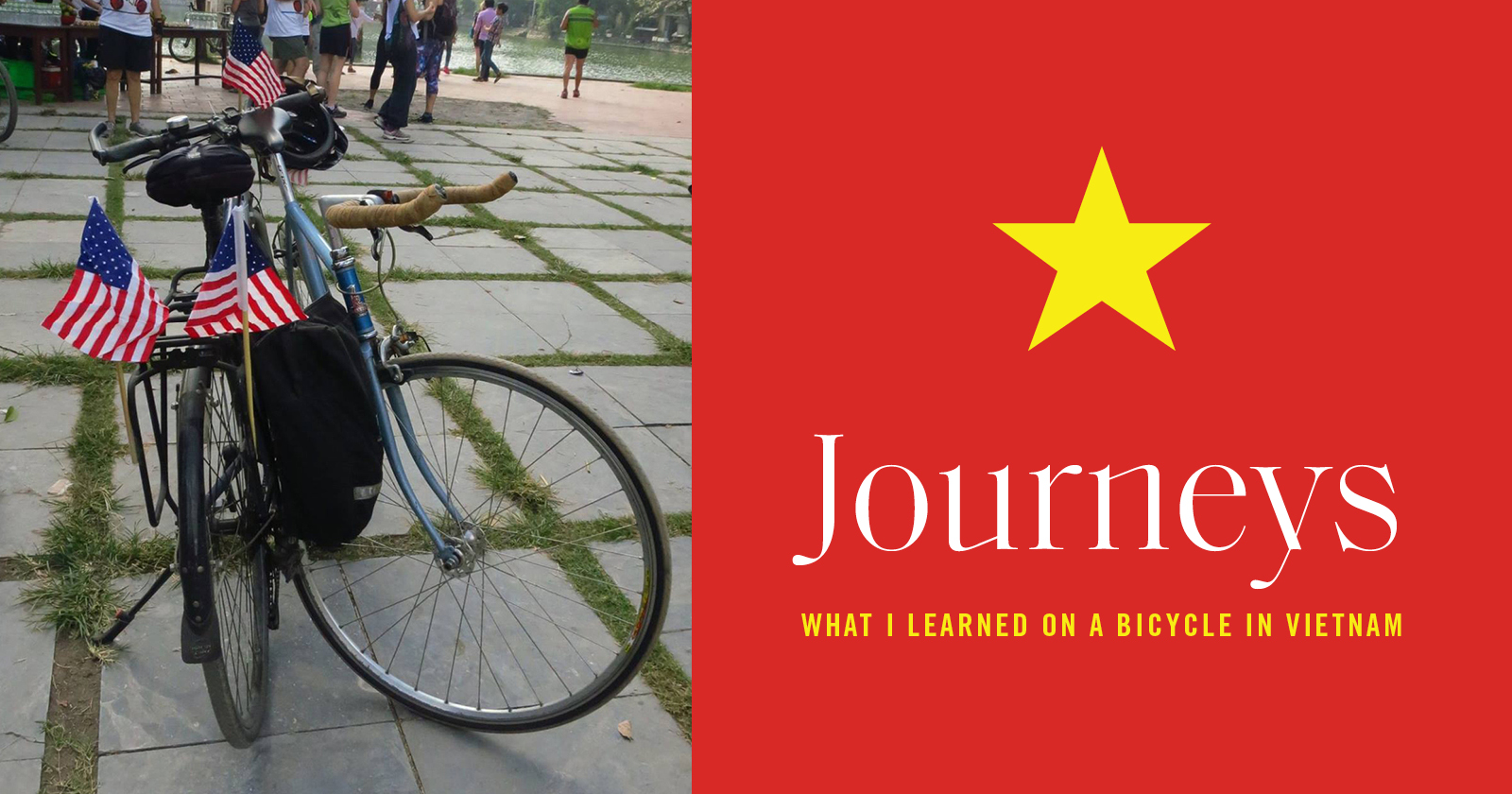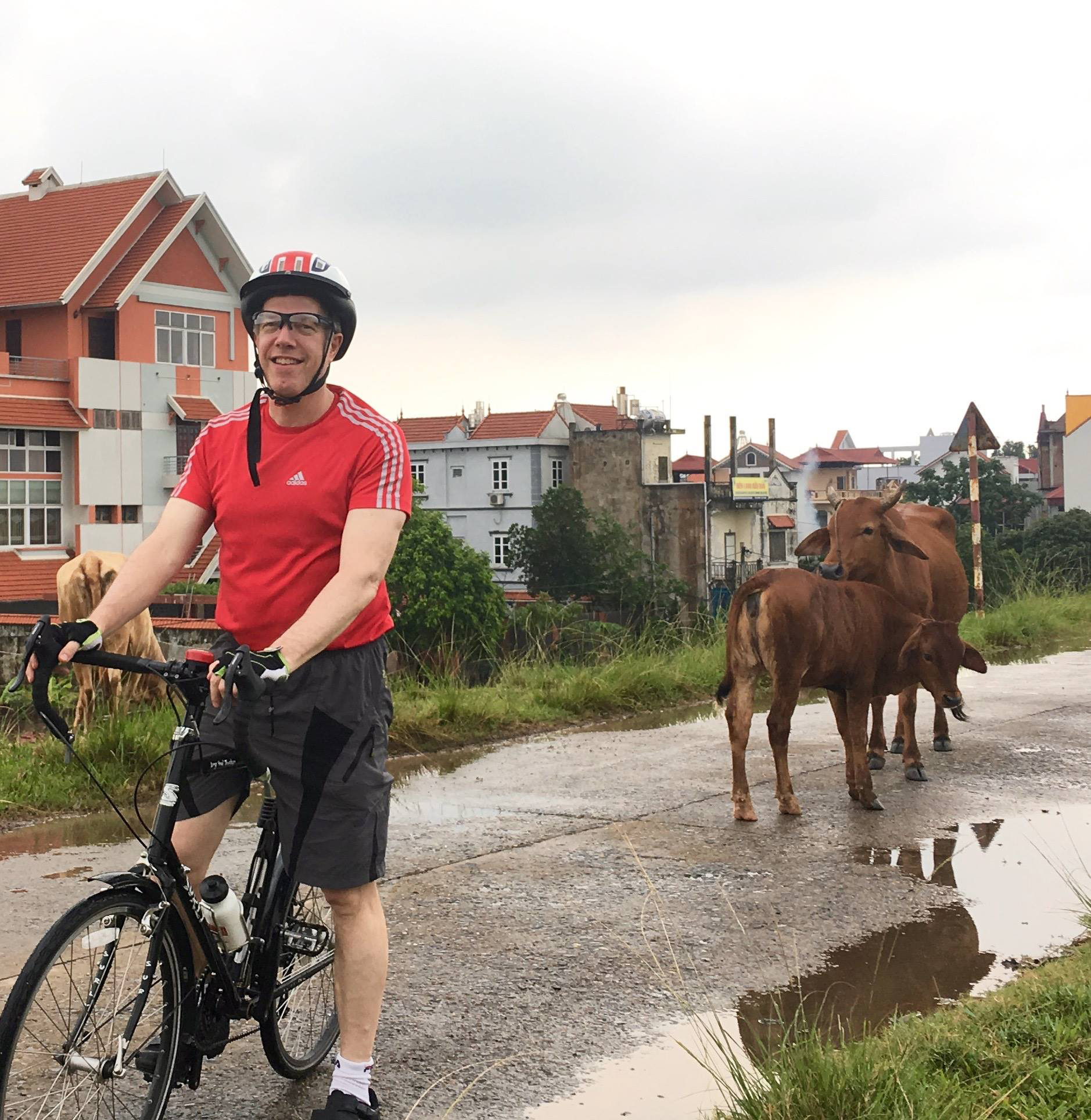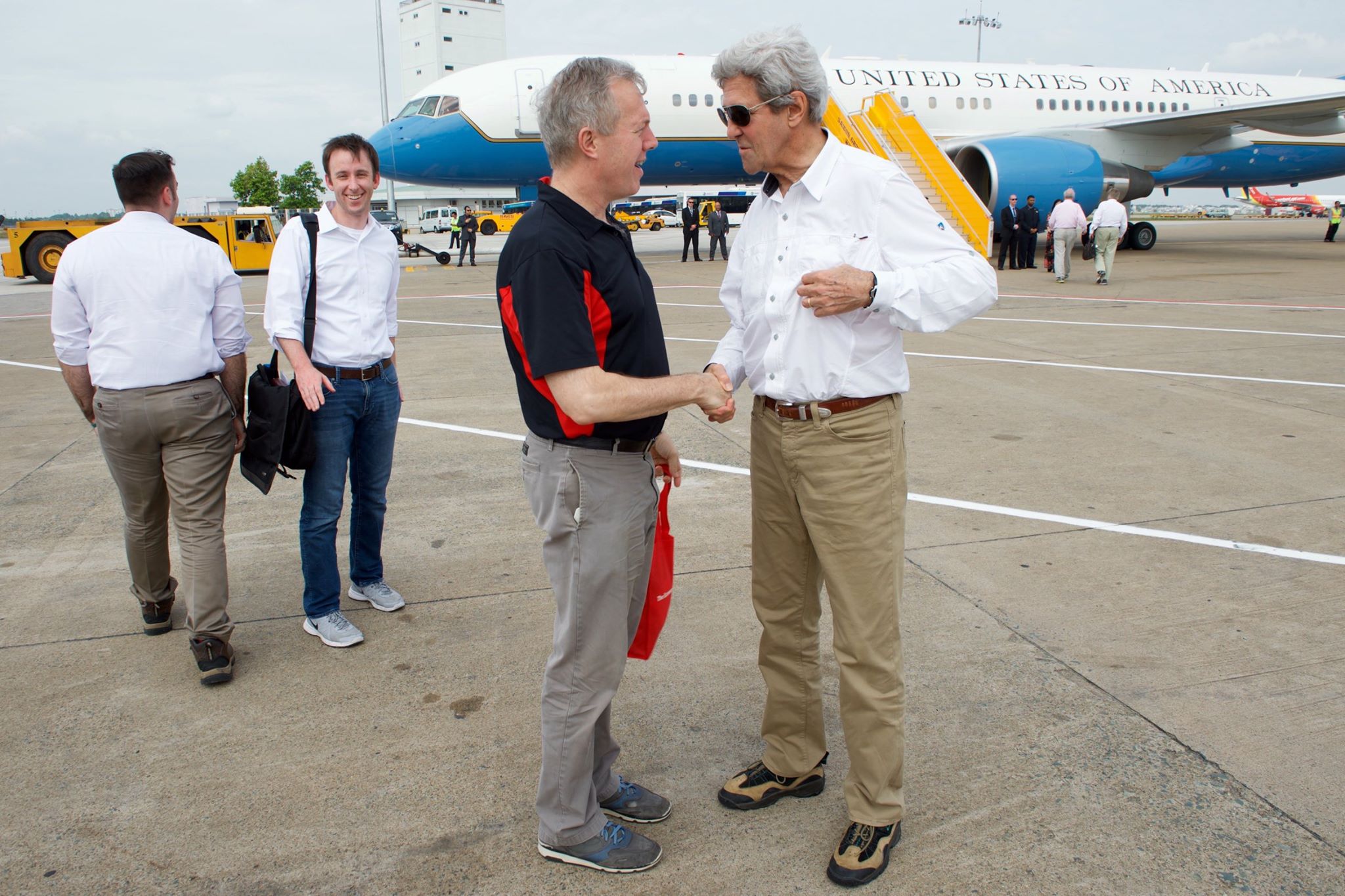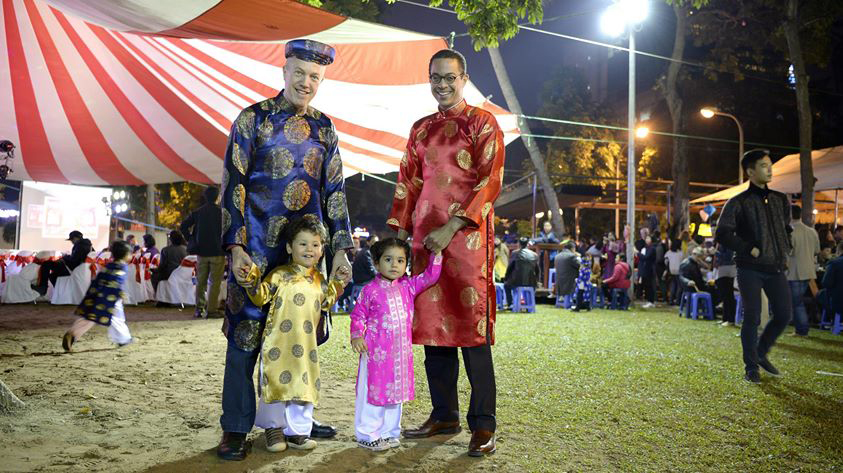
When Secretary of State John Kerry swore me in as America’s sixth ambassador to the Socialist Republic of Vietnam, he urged my family to join us on stage. Laughing about our infant son’s suit, the Secretary welcomed my mother, my husband Clayton, and our 11-month-old son. Our son, he said, “is decked out in the best seersucker suit I ever saw at that age. There he is. You can record the day that TABO stole the show.”
The Secretary continued, “I first met Ted in January of 1998, when I travelled to Vietnam to take part in a disabled veterans bike ride. The bikers had come down all the way from Hanoi; I joined the ride in Vung Tau, and we biked up to Ho Chi Minh City with a bunch of veterans who had been wounded in the war. And the heat and the humidity was pretty intense, as you can imagine, but the worst part of it was every time I’d look up Ted was just kind of biking along, leading the trail with ease, sort of a Sunday stroll for him. And I found out later that it was a Sunday stroll for him because he’s ridden the full distance of 1200 miles between Hanoi and Ho Chi Minh City, not just the final leg.”
That’s not exactly how I remember that bike ride. John Kerry is an avid biker and intensely competitive. I remember his tall, lean profile well ahead of me on the long, hot ride to Saigon. And the first ambassador to Vietnam, my boss Pete Peterson, was close behind his friend and fellow veteran, then-Senator Kerry. He had borrowed my bicycle seat to cushion his ambassadorial tush.
Of course, John Kerry was right that it was broiling hot and unthinkably humid. The war veterans and disabled participants who rode in the World T.E.A.M. Sports’ “Vietnam Challenge” bicycle ride had visited hospitals and orphanages along the route. Their journey was part of a long process of reconciliation between former adversaries. Veterans without the use of their legs rode hand-powered cycles, an unthinkable feat of determination on 100-mile days. They rode over the towering Hai Van Pass and the Hien Luong bridge spanning the 17th parallel that separated north from south during the war.

The “bicycle diplomat.”
That was one of many bike rides for me in Vietnam, from the north mountains on the border with China to the flat, fertile Mekong Delta. The practice for a new ambassador, before arrival, is to release a short video telling something about himself or herself. I chose a biking theme, to indicate to the Vietnamese people that I knew something about their country. I narrated the video entirely in Vietnamese, and pretty quickly the word spread that the new U.S. ambassador spoke the language and loved the country.
I rode my bike in the north, south and center—as often as possible—because I liked biking and the image it conveyed. While few modern Vietnamese leaders would be caught on camera riding a bicycle, I wanted the U.S. image to be one of accessibility and friendliness. The “biking ambassador” image caught on, including in the USA, where PBS News Hour broadcast a profile, “Meet bicycle diplomat Ted Osius, America’s modern ambassador to Vietnam.”
What did I learn on my bicycle seat? First, that the foundational skill of diplomacy is respect. When you show respect to people, to their history, culture, food, art and language, you can build trust. You can expand that trust by doing things together, which leads to partnership. Partnership—not transactional relationships —is in America’s interest. It’s also important that the respect be genuine, not just a show. That was easy for me, because I love and respect Vietnam, its people and its culture.
Second, I learned that if you want to make a difference, you must engage. You must engage patiently, persistently, again and again. If you want to have any kind of influence, you need to show up, and not walk away when the going gets tough. There were many things about the Vietnamese government that I did not like. (There are a lot of things about the U.S. government that I don’t like, either.) But if you engage, there is a real opportunity to change a relationship and make a lasting difference.
When I was a kid, my parents read to me a poem by Mary Lathrap, which had the line: “walk a mile in his moccasins before you abuse, criticize and accuse.” As a diplomat—and, I would argue, as a human being, it’s critical to know what’s fundamentally important to another person, and to understand his or her perspective, to walk a mile in his moccasins. That was the third lesson I learned on my bicycle seat.

Osius with then Secretary of State John Kerry, also a cycling enthusiast.
By the way, these foundational skills—showing respect, engaging in order to make a difference, figuring out the other’s perspective— are transferable. Regardless of whether you’re working in government, in education, in the arts or in the private sector, these skills will help.
As a diplomat, on my bicycle seat or in meeting rooms, I tried to promote reconciliation between two former enemies, and to bring the United States and Vietnam together as partners. The highlight of 28-and-a-half years as a diplomat was in 2016, when I hosted President Barack Obama in Hanoi and Ho Chi Minh City. Those three days were also the most challenging moments in my career.
In planning the trip, I had to bring together the U.S. and Vietnamese governments, and each had a different view of the visit. For the Vietnamese, it was essential that the U.S. president show respect by meeting with all four top leaders of the Communist Party. For the Americans, it was essential to get the president out of the official bubble, so that he could meet real Vietnamese and get a feel for what was actually happening in the country.
Earlier, I had helped Vietnam’s top Party leader get an Oval Office meeting, where President Obama voiced his respect for systems of government different from our own. That successful visit had earned me some credibility as a friend of Vietnam. I had to use that credibility to persuade Vietnam’s leadership that, by meeting with young people and interviewing entrepreneurs, Barack Obama was in fact showing his respect to all the people of Vietnam. I had to persuade them, for example, that forgoing a State dinner in favor of bun cha and beer with Anthony Bourdain was not an insult, but rather a compliment to Vietnam’s cuisine and its culture.
I tried to use all the foundational skills discussed above: showing respect, engaging, and understanding the concerns of all parties. But in one area—the sensitive realm of human rights—I couldn’t bridge the gap.

Osius with husband Clayton Bond and their children.
Trip planning really went off the rails as we arranged for President Obama to meet with civil society representatives in Hanoi. I had cut a deal with Vietnamese leaders so that President Obama could hold a roundtable discussion, and the Vietnamese reneged on that deal. Angry with both the Deputy Prime Minister and with another Politburo member who had abandoned his personal commitment, sealed by a handshake, I asked Secretary Kerry, “What do you do when someone betrays you?” Without missing a beat, he replied, “It happened to me yesterday. My advice is: don’t burn bridges. Let them know what went wrong, don’t slap them on the back, but don’t burn bridges.”
The event took place, but it was reduced in scope. Like Secretary Kerry, the President took a broader perspective. Although he would face criticism at home, President Obama considered thoughtfully the perspective (I would have said paranoia) of Vietnamese leaders. “They have never faced this before,” he said. “A visit by a head of state who wants to speak directly with activists. We will have to give them some time.”
So the fourth lesson I learned on the bicycle seat was from the president and Secretary of State. No matter how let down you might feel, don’t burn bridges. While you may face real setbacks, it is important to keep relationships going. I think these are lessons to live by, whatever journey you choose.

